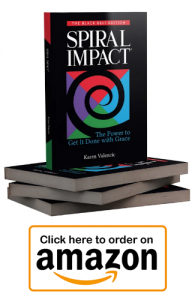Originally published on Newsweek Expert Forum here
Their words were muffled, but I could still hear bits of the conversation between two colleagues. I caught the phrases “I am frustrated” and “I feel undermined.” My impression was that they were in a conflict and trying really hard to apply techniques they had learned for resolution. But their tone and body postures clearly exposed their widening division.
In this tight talent market, the inability to communicate well during a disagreement has even bigger consequences, including the inability to retain employees, reduced productivity and innovation, your own termination, or even physical or mental illness.
Put simply, your career could tumble while you fumble with conflict.
Bringing a fresh approach to conflict may be the hardest of all skills to master since it challenges our emotions and security and brings up old wounds. Most people have learned their conflict response from terrible models, i.e., family or TV/movie characters.
I have found that teaching from a macro point of view, and then evolving into more details, is the most effective approach.
Using martial arts and simple physics, people experience firsthand what creates either positive movement or more resistance. For example, many people apply Newton’s third law of motion: For every interaction, there is an equal and opposite reaction. This creates huge resistance and only the strongest person “wins.” But that win happens only in the moment, and over the long term there is often a loss.
This is where I find the martial art aikido instrumental. This is lesser-known art that is based on position instead of force. I’ve practiced it for 30 years, and it has become what guides me in “mastering” conflict.
Here are three suggestions. Any one of them will shift you to a “black belt” state to begin to transform destructive conflict into innovative solutions.
Get Centered
In the martial arts, “centering” is internal balance and awareness. All powerful movement is initiated from this state of being.
As the world accelerates and change keeps coming, a centering practice is, I believe, an essential survival skill. There are many ways to integrate and build ‘center’ into your life. It’s best to find ways that are easy and have an immediate impact. For example, breathing practice is hugely important, and completely free. Breathing is closely correlated with your emotional state. The deeper and more conscious your breathing, the calmer and more aware your mind becomes. This centered state makes it much easier to navigate conflict.
Other tips include vividly remembering a time you felt ‘centered’ when all things seemed possible and you
felt clarity and calm. Re-create this feeling so that when situations get intense, you can recall your centered place.
Movement also creates a centered state. Think of the times you’ve rocked in a chair, swung in a swing, walked in nature — just to name a few.
Creating the time to develop and practice these skills is actually easier than trying to remember the minutiae of a technique, and it can have a profound positive impact on your well-being and your ability to communicate.
Had either of the colleagues in the above example ‘centered’ before they engaged, their emotions would likely have been more in check, making them less eager to place the blame on someone else.
Declare Intention
The most forgotten element in conflict is intention — conscious intention. Unconscious intention may be to protect one’s turf or to be right. It is unlikely that someone would verbalize those feelings. If you ask someone their conscious intention, it’s more likely something along the lines of “bring the best for our team,” “provide world-class service for our customers” or “develop a cutting-edge company.”
In the example I shared at the beginning of the article, I imagine that if the two colleagues thought through their conscious intention before spouting “I feel …” they may have gotten a different result. What if they began with, “My intention is to check in and make sure we are on the same page”?
In my aikido practice, the intention is to honor both the attacker and one’s own life. I encourage teams to create an agreement on their intention and how they’ll interact with each other. I like to guide them to create a credo, which consists of open-ended questions they create and agree to as a group. Again, a clear intention is easier to access in a heated moment.
Shed Light Before Acting
Practicing aikido with our eyes closed heightens all our senses to understand and then be able to diffuse an attack.
I liken this to walking into a dark room in an unfamiliar environment. Would you turn a light on? Of course, you would, if possible. The same is true of mastering conflict. Before you jump into the void of defensiveness or issuing commands, shed light on the situation by asking open-ended questions.
Had the colleagues above begun by asking questions, they may have learned something about the situation instead of assuming a motive. They also would likely have found the other person to be more open to what they had to say.
If you practice developing your centered state, get crystal clear on relationship/team intention and turn the light of understanding on before you make a move, you may just surprise yourself at how much easier it is
to navigate differences. You may discover options and ideas that were previously invisible.
The Newsweek Expert Forum is an invitation-only network of influential leaders, experts, executives, and entrepreneurs who share their insights with our audience.
Original link: https://www.newsweek.com/how-master-career-conflict-black-belt-perspective-1615271


